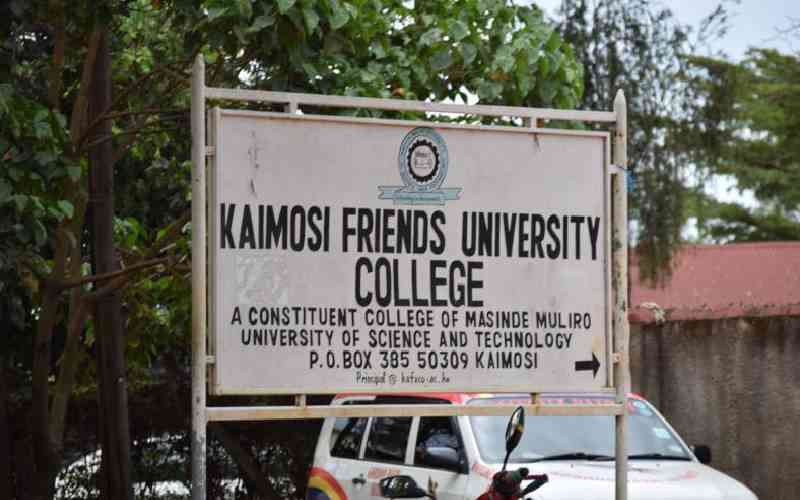Education Cabinet Secretary Fred Matiang’i has warned there is a serious problem with the framework of textbook distribution in public schools under the free basic education system.
The alarm is that after 13 years of Free Primary Education and eight years of Free Day Secondary Education programmes in the country, public schools have not attained the expected 1:1 pupil to textbook ratio.
Instead, the average pupil to book ratio is anywhere between 3:1 and 5:1, and in some cases, 10:1.
This reality cannot be reconciled with the billions of shillings that the Government annually allocates to textbooks for students in public Primary and secondary schools.
Three weeks ago, the Cabinet secretary dispatched a team comprising education officials from Jogoo House in Nairobi, County Education officials and Teachers Service Commission (TSC) in Nakuru County to several schools in Nakuru.
The report the officials prepared for him validated fears that students in some schools have been denied access to textbooks as envisaged by the policies, programmes and initiatives the government has undertaken.
This is the background behind the Cabinet secretary’s concern when he released the 2015 Kenya Certificate of Secondary Education examinations that in the last three years alone, the Government had pumped Sh9 billion into textbooks for secondary schools and Sh7 billion for primary schools.
The Government is raising valid questions. “Students spend from 70 to 95 per cent of classroom time using textbooks, and teachers base more than 70 per cent of their instructional decisions on them,” according to two American Professors of Education, Myra Pollack Sadker and David Miller Sadker in their book, ‘Teachers, Schools and Society’. They argue that textbooks are so pervasive and so frequently used that they constitute a curriculum of their own.
The thrust of the debate the Cabinet secretary has sparked is, given that textbooks provide a resource for learning essential content and acquiring or mastering literacy skills and other important concepts and ideas that define a good education, schools that have not narrowed pupil to textbook ratio are short-changing the students.
An excellent education is predicated on sustained and intense interaction between student and teacher, student and student and, crucially, between student and approved textbooks and relevant supplementary reading materials.
All the time during these interactions, the student is exposed to a prescribed body of knowledge; cultural, scientific, mathematic and technological and habits of thinking that the body of knowledge invariably imparts in the highly and even modestly motivated students.
Students make the best of the interactions when they have a direct interaction with prescribed textbooks, to say nothing of supplementary reading materials.
A good education is as good as the extent to which students have interacted not only with the teacher, and among themselves, but also with textbooks.
As we have earlier observed textbooks contain the essential content and skills that an education system seeks to impart and develop in learners.
Quality interaction with the textbooks helps the student integrate the knowledge or content in his or her mental structure: they become part of the furniture of the minds of the student so exposed to the content and skills. Worryingly, students who have little direct exposure to textbooks never come to have a functional mastery of the knowledge, skills and other capabilities that they ought to acquire.
Stay informed. Subscribe to our newsletter
Academic success depends in large measure on students ability to comprehend, understand and analyse the ideas, and issues and concepts that a prescribed curriculum embody for many purposes including tackling a national examination at the end of an education cycle.
Dr Matiang’i indicated that only 31.52 per cent (165,766 of the 522,870 candidates) attained the minimum university entry qualification of C+ and above in the 2015 KCSE examination.
Multiple factors are behind this picture. However, hidden in this statistics is the fact that many who fell short of attaining C+ may have suffered from the hunger for textbooks.
This is a debate Matiang’i has raised for discussion with a view to looking for a viable model for ensuring that books get into the laps of students in public schools.
The crucial role textbooks play in the education process made the Government to allocate 60 per cent of the tuition vote on textbooks with the expectations that several years down the line, a 1:1 pupil to textbook ratio would provide the instructional materials students need.
That has not been attained. And none has challenged the view that this ideal has not been attained.
Clearly, the current model of textbook distribution is wanting. With this background, we should understand the agony that is eating the mind of education officials and as well as the Cabinet Secretary for Education on how best to break the Gordian knot that defines textbook distribution in our public education institutions.
 The Standard Group Plc is a
multi-media organization with investments in media platforms spanning newspaper
print operations, television, radio broadcasting, digital and online services. The
Standard Group is recognized as a leading multi-media house in Kenya with a key
influence in matters of national and international interest.
The Standard Group Plc is a
multi-media organization with investments in media platforms spanning newspaper
print operations, television, radio broadcasting, digital and online services. The
Standard Group is recognized as a leading multi-media house in Kenya with a key
influence in matters of national and international interest.
 The Standard Group Plc is a
multi-media organization with investments in media platforms spanning newspaper
print operations, television, radio broadcasting, digital and online services. The
Standard Group is recognized as a leading multi-media house in Kenya with a key
influence in matters of national and international interest.
The Standard Group Plc is a
multi-media organization with investments in media platforms spanning newspaper
print operations, television, radio broadcasting, digital and online services. The
Standard Group is recognized as a leading multi-media house in Kenya with a key
influence in matters of national and international interest.








